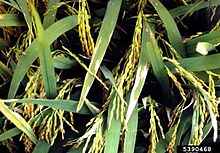Xanthomonas oryzae pv. oryzae
| Xanthomonas oryzae pv. oryzae | |
|---|---|
 |
|
| Xanthomonas oryzae pv. oryzae, Bacterial blight of Rice | |
| Scientific classification | |
| Kingdom: | Bacteria |
| Phylum: | Proteobacteria |
| Class: | Gamma Proteobacteria |
| Order: | Xanthomonadales |
| Family: | Xanthomonadaceae |
| Genus: | Xanthomonas |
| Species: | X. oryzae |
| Variety: | X. o. pv. oryzae |
| Trinomial name | |
| Xanthomonas oryzae pv. oryzae |
|
Xanthomonas oryzae pv. oryzae is a bacterium which causes a serious blight of rice, other grasses and sedges.
The genus Xanthomonas, which mostly comprises phytopathogenic bacteria, is a member of the family Xanthomonadaceae. Among xanthomonads, Xanthomonas oryzae pv. oryzae causes bacterial blight (BB) of rice which is one of the most important diseases of rice in most of the rice growing countries.
Bacterial blight of rice has high epidemic potential and is destructive to high-yielding cultivars in both temperate and tropical regions especially in Asia. Its occurrence in the 70s in Africa and the Americas has led to concerns about its transmission and dissemination.
Research on bacterial blight of rice was commenced in Japan as early as in 1901, and the efforts were focused mainly on ecological studies and chemical control. Since then, significant gains have been made in understanding BB through analysis of the interactions between X. oryzae pv. oryzae and rice at many levels, including studies focused on the epidemiology, population biology, physiology, cell biology, biochemistry, and molecular genetics of the host pathogen interaction. It is very notable that BB became the first case where the genome sequencing of both host plant and pathogen was completed.
There is a very large host range for Xanthomonas oryzae pv. oryza.
Among the grasses, hosts include:
Among the Cyperaceae (Sedges), hosts include:
In its advanced stages, the disease is difficult to distinguish from leaf blight caused by Xanthomonas oryzae pv. oryzicola, but lesion margins are wavy rather than linear as for the former. Damage is often associated with lepidopteran leaf rollers, leaf-folders and hispa beetles, since bacteria readily enter the damaged tissue caused by insect infestation.
Rice plants become infected with Xanthomonas oryzae through rice seed, stem and roots that are left behind at harvest, as well as alternative weed hosts. X. oryzae lives on dead plants and seeds and probably moves plant-to-plant best through pattywater from irrigation or storms. Upon introduction to the host plant, the bacterium infiltrates the plant through natural openings (water pores and growth cracks on roots) and/or leaf and root wounds. X. oryzae grows in the plant and infects the plants leaf veins as well as the xylem causing blockage and plant wilting. Bacteria oozes from leaf lesions and is spread by wind or rain, especially when strong storms occur and cause wounds to plants. X. oryzae has a wide host range that includes Leersia sayanuka which acts as alternative host for the bacterium and are considered the most important source of primary inoculums, as well as a great mechanism for bacterium survival.
...
Wikipedia
